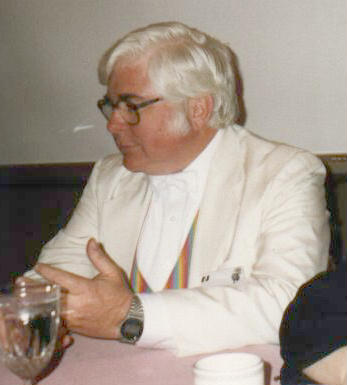We are developing the social individualist meta-context for the future. From the very serious to the extremely frivolous... lets see what is on the mind of the Samizdata people.
Samizdata, derived from Samizdat /n. - a system of clandestine publication of banned literature in the USSR [Russ.,= self-publishing house]
|
It is with heavy heart I pass on the news of yet another death in the space activist community. Dr. Charles Sheffield, one of many Brit expats who chased the dream of space flight across the big pond died yesterday.
I have no photos of Charles,1 although I interacted with him on an almost daily basis in the mid eighties. I was “the Prez” of the Pittsburgh L5 Society chapter and ran a local and an international L5 Conference and other space events for which he came up from the Washington, DC area to attend, assist with and speak at. We both served on the board of directors of the L5 Society during that period, so I worked with him in that capacity as well. At times we felt like he was part of our crazy bunch of hard drinking, hard partying, Steeler and Penguin cheering Spacers at Pittsburgh L5.
He was one of those whose life was utterly dedicated to our goal of moving off planet. He worked on commercial satellites by day; he wrote great hard science fiction by night; in all his spare moments he was an L5 Society activist… and how he found time to also raise a family I have no idea.
Vaya con Dios, Ad Astra and “next year in L5” Charles.
1 = There might be 1987 photo’s of him here but I have not had time to look through them all.
Many Samizdata thanks to reader FeloniusPunk who pointed out an article in the LA Times on the state of the art in laser weaponry. I must admit to being technologically blindsided and slack jawed after reading it.
I have been following the USAF conversion of a 747 into a chemical laser gunship (below) and I knew great advances had occured in solid state lasers… but nothing like this

Photo: USAF
What with islamic snipers, bombers and hostage takers, I never did get around to this story while it was current.
It seems the recent ground based anti-ballistic missile test was quite successful. Keep in mind this test series is an engineering effort and not testing of a product to be deployed. I point this out because most journalists I read don’t know the difference nor understand that bugs, glitches, failures, mistakes and blowing things up spectacularly are all part of everyday engineering R&D.
I must admit my own most spectacular glitch was not in the same league as these lads can accomplish. My “best effort” caused a dump of a fifty thousand gallon water deluge into a helicopter hanger outside Denver late one night in 1976. Well… it probably does rate well up the engineering test bug Richter scale. Fortunately for my career and possibility of future procreation, no helo’s were in at the time.
But that’s life in the world of engineering. “The thrill of victory and the agony of defeat”, along with a good healthy dose of the totally unexpected.
For the last couple years many pundits have expected a black aircraft to have a coming out party “Real Soon Now”. It has finally happened but the new debutante is not at all what anyone expected.
It’s neat looking but only a technology demonstrator. Slow, low ceiling… and very hard to detect.
Personally I think there are a few other rather more interesting craft still in the deep, deep black of Groom Lake.
 Photo: with permission, Boeing Aerospace
Photo: with permission, Boeing Aerospace
The Space Elevator concept is one I’ve always found to be of interest, but which I personally placed at least a century or more in the future. I remember many fun discussions in the early days of the sci.space netnews group; in which calculations of exponential tapers, masses and tensile strength tables were batted about gleefully. Carbon nanotubes were still in the future back then; and even in later discussions we all considered mass production of real fibres to be very far off.
Well, sometimes even those of us who have one foot in the next decade are too pessimistic. A company, High Lift Systems, has been formed to work on a near term design. Advances in production of carbon nanotubes have (mostly) solved the last basic problem. We will soon be able to build sufficient quantities of sufficiently strong material to actually build one.
Of course there is that one little detail of raising $10 billion dollars in the capital markets…
Making dire predictions about the organisational abilities of the European Union is a fairly safe bet I reckon, but even I have been taken aback by the speed with which this prediction (from early April):
“So, cue another round of horse-trading, bickering and monumental waste as each part of the Galileo project is apportioned out according to who makes the most noise. The French will build the electrics, the Italians will build the housing, the Belgians will make the navigation system, the Germans will make the rocket boosters, the Spanish will make the launch platform, the Austrians will make the sandwiches and Sweden will provide the environmental protestors.”
has become this reality:
“Germany and Italy are fighting it out within the European Space Agency for the right to provide the main production base for the satellite system, to which EU governments gave the green light in March.
Their dispute has prevented the ESA from beginning work on the project and risks setting back its projected completion date of 2008.”
I submit that I am entitled to enjoy a brief frisson of self-congratulation.
[My thanks to Philip Chaston for the second link]
Armadillo Aerospace has finally let one of it’s team fly on their testbed. Although the flight was a tethered one of short duration and trivial height, it encompassed all the dangerous bits of engine startup, liftoff, hover, setdown and engine shutdown. Major kudos are due to John Carmack and his team! You can read more and find the video here.
In John’s own words:
We finally let someone ride on one of our landers. Only a few seconds in the air, but still pretty damn cool!
If the name John Carmack sounds familiar… it’s probably because it is. He is a founder of Id Software and the author of all those classic state-of-the-art pushing games from Castle Wolfenstein through Quake Arena and beyond.
I’ve just received email notice of the death of Dr. Robert L. Forward. He’s known to some for the wonderful “hardest of the hard” Science Fiction he wrote; to others for his cutting edge work in physics and propulsion systems; and to still others for his loud vests, boyish exuberance, smile and tossled white hair. At any conference his gesticulating presence around the bar of the hospitality suite was certain. He carried all around him on a race through one stunningly creative idea after another.
I last talked to Bob in May when he was of enormous help as I put together a conference track on Novel Propulsion Systems. “Enormous help” from Bob was the rule, not the exception. He’s been of assistance to me so many times over the twenty years in which I have had the good fortune to know him I would be filling pages if I were to itemize.
All I can say is, we’ll miss you Bob. Intellects and personalities wrapped up with warmth and caring like yours are more than few and far between: they are nearly non-existant.
 Bob Forward at 1992 National Space Society
Bob Forward at 1992 National Space Society
conference in Washington, DC. (photo: D. Amon)
I’ve just been reading a very long transcirpt of a DOD press briefing entitled “Gen. Kernan And Maj. Gen. Cash Discuss Millennium Challenge’s Lessons Learned“. It’s about the recent experiments in future warfighting methods, techniques, procedures, C-cubed and so forth. It’s a very long transcript. I woke abruptly from a deep alpha state when I read this comment by Cash:
And the big idea is, I want to be able to, as a concept developer, strike any target on the globe within 45 minutes from the time the president says, “Strike”. Forty-five minutes. That’s the big idea. Then I want to follow up that strike in 20 hours with a ground force. That’s the big idea.
Hands up for everyone who recognizes the significance of “45 mimutes”.
Objects in a Low Earth Orbit (LEO) do one full orbit every 90 minutes. The exact time varies with the orbital parameters, but this has been a rough number for human operations from the time of John Glenn to the time of the International Space Station. 45 minutes is one half an orbit, the time required to reach the antipodes from where you sit.
Maj General Chases’ requirement can only be fulfilled by a suborbital spacecraft or a space based weapon. Since these experiments were aimed at studying future warfighting capabilities and requirements, I would suggest he is thinking about a manned suborbital bomber. It is technically feasible in the near term and I personally know of at least one USAF guy who was pushing for the idea a decade ago. He left the service but that does not mean his ideas died.
It’s not that far out and there are those of us who think it might already exist in the very deep black world. More because it could and because it would be rather useful than because we “know” anything.
It just seems like such a bloody good idea.
More from my webwanderings. This is from sashinka, who is one of the other bloggers that the Guardian bloggers like.
One of the other students revealed [that] adopting the Brace Position during airplane emergencies does not improve your chances of surviving an impact. What it does do is preserve the location of your teeth in proximity to your mortal remains in order to aid forensic odontologists in corpse identification.
That sounds horribly true to me. Sashinka got it from somewhere (don’t know where) in a blog/website/virtual place called Methysalicylate. Most blogs go up and down, but Methy-etc. scrolls sideways. Well why not?
What happens when a “we-didn’t-go-to-the-moon” moron calls an astronaut a liar? Yep. You got it in one. He gets decked… and that is exactly what happened when Bart Sibrel, an ignoramus, shoved a camera in Buzz Aldrin’s face.
One should remember Buzz is in his 70’s at the very least. So we have here a demonstration of what a lifetime of physical fitness can do. Mr Sibrel should consider himself lucky… had he done this twenty years or more ago, he would now be doing a richly deserved pretzel impression in an emergency room.
Congratulations to Buzz for giving Mr Sibrel his just deserts… and he’s definitely got my vote the next time he runs for the NSS board!

Buzz Aldrin chatting with members of National Space Society
at their 1992 conference in Washington, DC (photo: D.Amon)
When I was deciding on a category to select for this glorious bit of news my cursor flickered momentarily over the ‘Science Fiction’ section because this item has ‘Heinlein’ written all over it.
Except that it’s true. An American company has been given the go-ahead by the Federal Government to launch the first private moon landing:
“TransOrbital of California has become the first private company in the history of spaceflight to gain approval from the US authorities to explore, photograph and land on the moon.”
I can hear the sound of rusty, iron floodgates opening.
“Several other private companies are pursuing Moon missions. LunaCorp of Virginia also wants to put a satellite into lunar orbit in 2003.”
And the seductive fizz of genies escaping from bottles.
“The Moon is ripe for commercial development,” said Dennis Laurie, of TransOrbital.”
That’s what we want to see; the commercial development of the moon and the whole solar system beyond. ‘Would you like fries with your McVenus, sir?’. Next stop: the stars!
Who knows, maybe, one day, it will even spread to Europe?
|
Who Are We? The Samizdata people are a bunch of sinister and heavily armed globalist illuminati who seek to infect the entire world with the values of personal liberty and several property. Amongst our many crimes is a sense of humour and the intermittent use of British spelling.
We are also a varied group made up of social individualists, classical liberals, whigs, libertarians, extropians, futurists, ‘Porcupines’, Karl Popper fetishists, recovering neo-conservatives, crazed Ayn Rand worshipers, over-caffeinated Virginia Postrel devotees, witty Frédéric Bastiat wannabes, cypherpunks, minarchists, kritarchists and wild-eyed anarcho-capitalists from Britain, North America, Australia and Europe.
|







